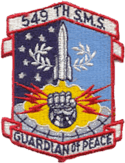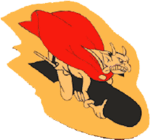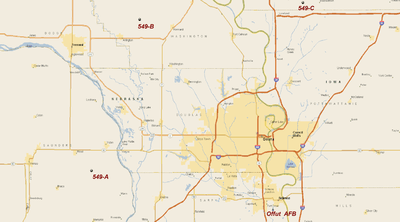549th Strategic Missile Squadron
| 550th Strategic Missile Squadron | |
|---|---|
|
549th SMS SM-65D Atlas missile arriving At Offut AFB NE 1961 from Douglas C-133A-35-DL Cargomaster, 57-1614 | |
| Active | 1942-1949; 1961-1964 |
| Country | United States |
| Branch | United States Air Force |
| Type | ICBM Missile Squadron |
| Engagements |
World War II (EAME Theater) |
| Decorations |
Distinguished Unit Citation (2x) |
| Insignia | |
| 549th Strategic Missile Squadron emblem |
 |
The 549th Strategic Missile Squadron (549 SMS) is an inactive United States Air Force unit. It was last assigned to the 385th Strategic Aerospace Wing, stationed at Offut AFB, Nebraska.
The 548 SMS was equipped with the SM-65D Atlas Intercontinental ballistic missile (ICBM), with a mission of nuclear deterrence. The squadron was inactivated as part of the phaseout of the Atlas ICBM on 15 December 1964.
History
World War II
Activated in late 1942 as a B-17 Flying Fortress heavy bomb squadron, trained under Second Air Force. Deployed to England in the European Theater of Operations (ETO) during June 1943, assigned to VIII Bomber Command as a strategic bombardment squadron. Participated in the air offensive over Nazi Germany and Occupied Europe until German capitulation in May 1945. Personnel demobilized in England and returned to the United States; squadron reassigned to Second Air Force and was programmed to be re-equipped with B-29 Superfortresses for deployment to Pacific Theater. Japanese capitulation led to units inactivation in September 1945, being neither manned or equipped.
Effective 15 September 1947, the squadron was activated at Selfridge Field, Michigan. Having been allotted to the organized reserves, with assignment to Second Air Force, Air Defense Command, it was redesigned as a very heavy bombardment unit on 25 August. In July 1948, the squadron was assigned to the Tenth Air Force, which in December, became a part of the Continental Air Command. The squadron was inactivated on 27 June 1949 due to budget restrictions.
Intercontinental Ballistic Missile Squadron
Reactivated in 1960 as a Strategic Air Command SM-65D Atlas ICBM launch squadron. On March 30, 1961, SAC placed the 549th Strategic Missile Squadron on operational status.
The squadron was assigned nine missiles, based in a 3 x 3 configuration: three launchers and one combined guidance control/launch facility constituted a launch complex, and three dispersed complex locations comprised the squadron.
The missiles were housed in a "coffin launcher" style complexes. The missile was kept in semi-hard facilities in which the missile was stored above ground horizontally above ground. In order to launch, a 400-ton overhead door was rolled back after which the "bird" was raised to a vertical position. Once upright, the rocket was fueled with RP-1 and Liquid Oxygen after which it would then be made ready for launch. (see below for site details).
Missiles were retired and removed in late 1964 in favor of the more advanced LGM-25C Titan II; squadron was inactivated on 15 December. Missile sites were later sold off to private ownership after demilitarization. Today the remains of the sites are still visible in aerial imagery, in various states of use or abandonment; Site 549-B appears to be very well preserved with the missile blockhouse and most structures still being intact including the three launch pads.
Lineage

- Constituted as 549th Bombardment Squadron (Heavy) on 25 November 1942
- Activated on 1 December 1942
- Inactivated on 28 August 1945
- Re-designated 549th Bombardment Squadron (Very Heavy) on 25 August 1947
- Activated in the reserve on 15 September 1947
- Inactivated on 27 June 1949
- Re-designated 549th Strategic Missile Squadron, and activated, on 19 April 1960
- Organized on 1 October 1960
- Inactivated on 15 December 1964
Assignments
- 385th Bombardment Group, 1 December 1942 – 28 August 1945
- ETO Fuselage Code: XA
- Second Air Force, 15 September 1947
- Tenth Air Force, 1 July 1948
- First Air Force, 15 August 1948
- Tenth Air Force, 1 December 1948 – 27 June 1949
- Strategic Air Command, 19 April 1960
- 385th Bombardment (later Strategic Aerospace) Wing, 1 January 1963 – 15 December 1964 (not operational, December 1–15, 1964)
Stations
|
|
Aircraft and missiles

- B-17 Flying Fortress, 1942–1945
- B-29 Superfortress, 1947-1949.
- SM-65D Atlas Missile, 1961–1964
- Operated three missile sites of three missiles at each site (9 total):
- 549-A, 3.4 mi SE of Mead, NE 41°11′37″N 096°26′23″W / 41.19361°N 96.43972°W
- 549-B, 3.6 mi NE of Arlington, NE 41°29′17″N 096°17′59″W / 41.48806°N 96.29972°W
- 549-C, 4.3 mi SE of Missouri Valley, IA 41°31′15″N 095°49′09″W / 41.52083°N 95.81917°W
See also
References
![]() This article incorporates public domain material from the Air Force Historical Research Agency website http://www.afhra.af.mil/.
This article incorporates public domain material from the Air Force Historical Research Agency website http://www.afhra.af.mil/.
- Maurer, Maurer, ed. (1983) [1961]. Air Force Combat Units of World War II (PDF) (reprint ed.). Washington, DC: Office of Air Force History. ISBN 0-912799-02-1. LCCN 61060979.
- Maurer, Maurer, ed. (1982) [1969]. Combat Squadrons of the Air Force, World War II (PDF) (reprint ed.). Washington, DC: Office of Air Force History. ISBN 0-405-12194-6. LCCN 70605402. OCLC 72556.


